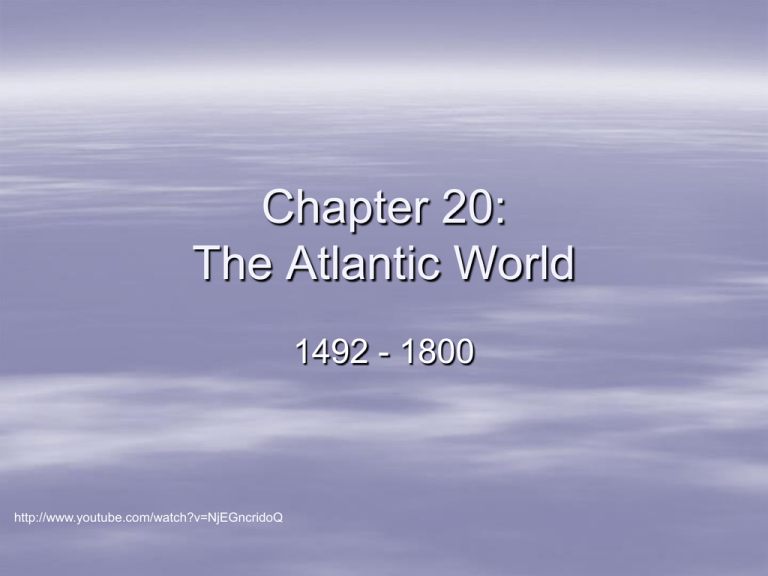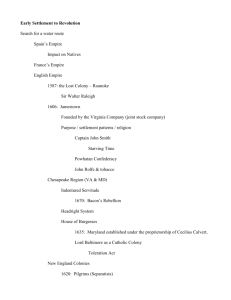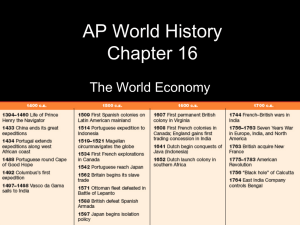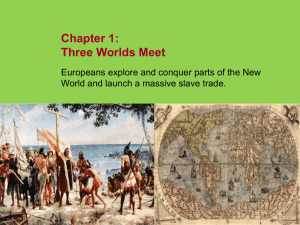Chapter 20, Sections 1 & 4: The Atlantic World
advertisement

Chapter 20: The Atlantic World 1492 - 1800 http://www.youtube.com/watch?v=NjEGncridoQ Chapter 20 Overview Chapter 20: The Atlantic World Section 1: Spain Builds an American Empire Section 2: European Nations Settle North America Section 3: The Atlantic Slave Trade Section 4: The Columbian Exchange and Global Trade Section 1: Spain Builds an American Empire Background: Competition for wealth among Europeans + Exposure to “cool stuff” from the “East” via Silk Roads and Crusades + improvements in sailing + Arabic inventions (astrolabe) + Prince Henry the Navigator’s School for Sailors + interest in cartography + wealth + new thinking from Renaissance = Era of Exploration http://www.youtube.com/watch?v=rjhIzemLdos Christopher Columbus Approach Isabella and Ferdinand (of Spain) shortly after Moors had been kicked out by the Reconquesta – Perfect timing! – Isabella provided backing for initial voyages, and the 3 voyages afterwards – “I’ll sail to Asia and open up trade with the Indies.” Well…got to the Caribbean instead. “In 1492 Columbus sailed the ocean blue…”. The Three G’s Early explorers and conquistadors interested in just 3 things: –Gold –Glory –God – (In that order!) Columbus’s 2nd voyage provided a means to establish an empire – Abused local natives – Established colonies throughout Caribbean – Later conquistadors came with Columbus on these voyages Other Explorers Pedro Alvares Cabral (Portugal): Brazil and claimed it for Portugal in 1500 – Treaty of Tordesillas: 1494, Spain and Portugal divide new world Ferdinand Magellan – Circumnavigated the globe, proving: It could be done (sailing around the world) You could get “East” by sailing West The natives on the Philippines are nasty This trading thing is very, very profitable! Hernando Cortez and the Aztecs Became a conquistador – Heard of Aztecs – Landed on Carib. shore – Found locals to help him Arrived in year 1 Reed—pale faced and with a beard! How able to conquer an empire of millions with about 600 men and some native allies?!?! – “Luck”, diseases, superior weapons, legend, horses, native allies Francisco Pizarro and the Inca Pizarro and 200 men ambushed Atahualpa and 30,000 men! – Again, superior weapons, disease (small pox had already come prior to Spaniards even showing up), horses, etc. – Kidnapped Atahualpa, held him for ransom—then killed him anyway Spain’s Empire in the Americas By mid 16th C., had “New Spain” in Mexico, etc., and “Peru” in Ctrl/So. America – Regional capitals – Local governors Imposed culture among natives – Intermarried mestizo population – Converted to Catholicism Encomienda system—forced labor from Native Americans – Natives resisted, ran away, etc. (And many just died!) Worked on plantations, mines, etc. Spain’s Influence Expands Spain becoming very rich – Built a huge navy (or armada) to protect ships Expand to (modern) United States – Send explorers throughout SW, southern Plains – Coronado explored 9 different states Looking for the “Cities of Cibola” Found the Grand Canyon instead Priests went everywhere – Established colonies, churches, etc. – Priests did much of the colonizing in New Mexico, which became HQ for Church in New World Opposition to Spanish Rule Harsh rule, many abuses of natives (and even mestizos) – Harsh, rigid social system—if you weren’t born in Europe, you were “nothing” – Some natives rebelled; objecting to harsh rule and culture being destroyed Priests started to be concerned – Bartolomé de Las Casas suggested using Africans for labor instead – Why Africans? New to area (won’t run away), “stronger”, and have “some immunity” to Old World diseases; plus, just running out of natives! – Importation of African slaves began In Brazil… Cabral claimed land for Portugal in 1500 1530’s…colonial period began – Little minerals, so grew sugar instead – Made Portugal very rich Also fell into slavery, and imported more slaves than all other areas in the New World combined Rigid social class system like Spanish areas Section 2: European Nations Settle North Amer. New France: – Who? Jacques Cartier, Samuel de Champlain, Sieur de la Salle – Why? Establish trade, esp. providing furs; not necessarily inhabiting the lands, but just “using” – Where? Originally up the St. Lawrence River – Important dates: 1534: Cartier (St. Law Ri) 1608: Champlain founded Quebec, claimed “New France” 1673: Marquette and Joliet: Upper Mississippi Ri. English Arrive Who? Male settlers, Pilgrims, Puritans Why? Religious freedom; start a new life Where? “New England”, VA, MA Important dates: – 1607: Jamestown: $ $ $ All men. By 1620, women and slaves have arrived. Tobacco. – 1620: Plymouth: Pilgrims and “Strangers” – 1630: Mass. Bay Colony: Puritans – 1763: French and Indian War open way for English to inhabit most of North America Dutch Are Next Who? Henry Hudson, others Why? Trade; searching for NW Passage Where? Hudson River; Manhattan Island Important dates: – 1609: Hudson River – 1621: New Netherlands established – Kicked out by English between 1664 - 1750 Native Americans React and Revolt French and Dutch had decent relationships, but English did not Various “Indian Wars” throughout 13 English Colonies Many fall to disease, loss of resources, kicked farther west – Small pox, others Section 3: The Atlantic Slave Trade Was already an established business in Africa 650 Muslims transport about 17 mil. Africans to No. Africa and SW Asia 1400-1500 Portuguese explore Africa 1500-1600 Spain and Portugal colonize Americas; began enslaving Africans *300,000 Africans 1600-1700 Atlantic slave trade grows dramatically under Spain and Portugal *1.3 million! 1690 England increases Atlantic slave trade 1870 Atlantic slave trade ends Triangular Trade Route http://www.youtube.com/watch?v=dnV_MTFEGIY 20% would die, tossed overboard Slavery in the Americas Conditions – Horrible! – Field, forests, rice paddies, mines, houses – Beatings, starvation – Lifelong and hereditary – Some masters okay, but others were ruthless Resistance, Rebellion, and How to Cope – Keep African culture alive – Stories, music – Would be less productive; sabotage efforts – Ran away – Armed revolts/Uprisings Consequences of Slave Trade In Africa – Lost generations of people – Families torn apart – Introduced guns, encouraged violence among African peoples In America (all) – Contributed labor – Assured some colonies would succeed and prosper – Brought culture, which mixed with natives + Euros – Many nations today are predominantly AfricanAmerican Section 4: The Columbian Exchange and Global Trade Exchange of plants, animals, diseases, etc. from Old World (Europe, Asia, Africa) to New World (Americas) – Not all good…not all bad. – Forever changed life for almost everyone on the whole planet! – Brought the extinction of many cultural groups of Native Americans. Most important (positive) exchanges? – From East to West: livestock, bananas, wheat – From West to East: potato, corn http://www.youtube.com/watch?v=HQPA5oNpfM4 Global trade New sources of wealth Rise of capitalism – Economic system based on private ownership and investment as a way to make money – Profits! Reinvestment! Etc. Increase in money supply Inflation Joint-Stock Companies – Like a corporation—investors pool money (buy shares) in hopes of getting a profit – Reduces individual financial risk – Popular way to “pay” for colonization Mercantilism (boo! hiss!) “Colonies exist for the sole purpose of making money for the mother country.” – Provides raw materials – Forced to buy finished products (but from factories in mother country) It’s good for the mother country, if: – There’s lots of gold and silver, or – There’s a favorable balance of trade. Spain England Goal: Become self-sufficient (off of your colonies) to eliminate need for trade with other “imperial powers”



